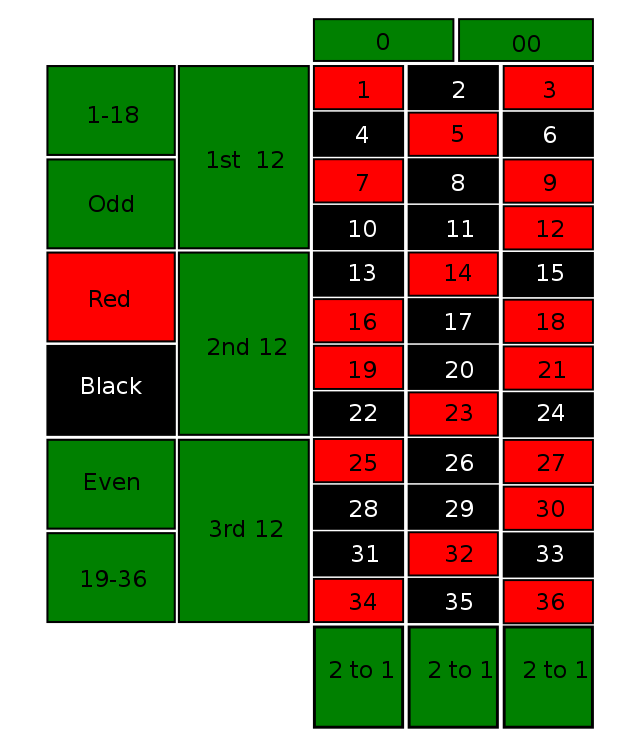Understanding Roulette Odds & Payouts

The best way to improve your roulette game is to know how the odds and payouts work. This page will explain the difference between European and American roulette and how that difference affects the house edge, as well as provide a full breakdown of roulette odds, payouts and house edge.
American vs. European roulette odds
American and European roulette seem similar, and in many ways they are. There?s a ball, a wheel and a bunch of bets you can place, all in a similar layout. So, what?s the catch? American roulette has an extra green pocket on the wheel.
In European roulette, there are 36 numbered black and red pockets and a single green zero pocket. On the other hand, American roulette has 36 red and black pockets but two green pockets: zero and double zero. This subtle yet crucial difference affects the odds of winning.
In European roulette, the odds of the ball landing on 10, say, are 1:37 since there are 37 numbered pockets on the wheel. Those odds increase to 1:38 when it comes to American roulette.
Another key feature here is that the roulette table payouts for both versions are the same, 35:1 when you bet on a single number like that. Note that the payout is 35:1 to create a house advantage. Thanks to the extra zero space, that advantage in American roulette is 5.26%, while it?s 2.7% in the European version.
Some rules in French roulette ? which also has just a single green zero pocket ? help players cut even further into that house edge. The ?la partage? rule allows players to recover half of their initial stake for even-money bets (high-low, red/black, even/odd) if the ball lands on zero. A specific variant of this rule is ?en prison? or ?in prison,? if translated literally. If you backed an even-money bet and the ball landed on zero, you can leave your stake there for the next round.
As for American roulette, it too has its quirk. There is a ?five number? bet you can place that covers the numbers 1, 2, 3 and the two zeros. The bet offers a 6:1 payout for a 7.9% house edge, so it looks appealing only on the surface. In the long run, it is better to avoid it.
Want to get a feel for these popular online table game variants before parting with your own money? Then why not first play roulette online for free at top US casino sites.
What are the different payouts in roulette?
There are multiple bets in roulette, no matter which version of the game you play at your local or online casino. These bets fall into two categories ? inside and outside bets. Their names come from their positions on the table layout.
Outside bets offer a greater probability of winning, but their payouts are lower than inside bets. On the other hand, the probability of winning inside bets is significantly lower. Here?s a rundown, starting with inside bets:
Payouts for inside bets
- Straight bet ? You bet on a single number and win if the ball lands on that number. The payout is 35:1.
- Split ? A bet on two horizontally or vertically adjacent numbers, such as 8 and 9. The payout is 17:1.
- Street ? A bet on three consecutive numbers ? for example, 4, 5 and 6. The payout is 11:1
- Square ? Bet on four numbers that meet at a corner of the table, such as 17, 18, 20 and 21, and the payout is 8:1.
- Double street ? The double street, or six-line, is a bet on six numbers in a row from two horizontal lines. You place a chip where the two rows of numbers overlap. The payout is 5:1.
- Trio ? Similar to the street bet, only this one has to include one zero ? for example, 0, 1 and 2. The payout is 11:1.
- Top line ? The top line or basket bet is available only in American roulette and involves betting on five numbers in total, starting with zero, then double zero, 1, 2 and 3. The payout is 6:1.
Payouts for outside bets
- Even/odd ? Bet on whether the number the ball lands in an even or odd slot (zero is neither). The payout is even money, or 1:1.
- Red/black ? Since all numbers, excluding zero, are black or red, you can bet on one of those two colors. There are 18 black and 18 red pockets. This is another one of those even-money bets that pay 1:1.
- Low/high ? A low bet pays out if the ball lands anywhere from 1 through 18, and a high bet is from 19 to 36. Payout is 1:1.
- Dozens ? You?re betting on the ball landing somewhere in the first (1-12), second (13-24) or third dozen (25-36), so you can bet on each one of those. Payout is 2:1.
- Columns ? Bet on a vertical column of 12 numbers. Same payout as a dozens bet: 2:1.
Roulette payouts and odds chart
Which bets offer the best roulette odds? The following table gives you a full overview of all the main roulette bets, their payouts and the odds of hitting those bets. Note that the house edge for European roulette is 2.7%, while it grows to 5.26% for American roulette.
| Bet Type |
Payouts | European Roulette Odds | American Roulette Odds |
|---|---|---|---|
| Straight | 35:1 | 2.7% | 2.6% |
| Split | 17:1 | 5.4% | 5.3% |
| Street | 11:1 | 8.1% | 7.9% |
| Square (corner) | 8:1 | 10.8% | 10.5% |
| Double Street | 5:1 | 16.2% | 15.8% |
| Trio | 11:1 | / | / |
| Six Line | 5:1 | 16.2% | 15.8% |
| Top Line (American) | 6:1 | / | 13.2% |
| Even/Odd | 1:1 | 48.6% | 47.4% |
| Red/Black | 1:1 | 48.6% | 47.4% |
| Low/High | 1:1 | 48.6% | 47.4% |
| Dozens | 2:1 | 32.4% | 31.6% |
| Columns | 2:1 | 32.4% | 31.6% |
How to calculate roulette payouts
Calculating the payout odds in roulette isn’t complicated. The only thing you need to observe is the number of pockets on the wheel and how many numbers on it a specific bet covers.
Here?s the formula for a straight bet in European roulette. If ? is equal to the numbers a specific bet covers, here is how you calculate the odds:
- odds = ((36-?)/?)) / 1
This means that for a straight bet in roulette, the odds will be as follows ((36-1) / 1)) / 1 = 35, or 35 to 1. For a split bet in roulette, you have ((36-2)/1))/1 = 17, or 17 to 1.
House edge in roulette
There?s no reason to be intimidated by the math behind the roulette house edge, either. We will use the European roulette wheel and the straight bet as an example.
There are 37 possible numbers you can bet on in European roulette, so the chances of getting the correct one are 1:37. However, the casino will only give you a payout of 35:1 for that bet. This means that for every $1 you bet, you would get $35 in profit on a correct wager, totaling $36 when you account for the stake you get back. That difference of $1 (37-36) represents the house advantage.
If you divide that house advantage by the total options and multiply the result by 100 to get the percentage, you get the following:
- 1/37 = 0.0270270 x 100 = 2.70270, or 2.7%.
By not paying you the actual odds for the game, the casinos ensure a house advantage.
Standard deviation and roulette
The standard deviation represents how far from the mean an outcome may be. Here, the mean is the average number of times you can expect to win over many spins. The standard deviation tells you the typical deviation from that mean.
To calculate the mean, you need to consider the number of spins, the probability of winning and the probability of losing. For example, the mean for the black/red bet out of 100 equals the number of winning outcomes divided by the total outcomes multiplied by 100. That would be 18/37 x 100, or 48.648 times out of 100.
Now, we move to variance, the deviation of probabilities from the average. We calculate variance by multiplying the number of spins by the likelihood of winning and the probability of losing, or the mean multiplied by the probability of losing. The probability of losing this bet is 19/37, or 0.5135, and when you multiply it with 48.648, you get 24.981. The standard deviation is the square root of that number, or 4.998.
Tips for limiting losses in roulette
Understanding the odds and payouts for each bet is key to understanding roulette. While the payouts for inside bets may be tempting, the better odds of winning outside bets, even with lower payouts, are generally the way to go.
Also, don?t bet big unless you want to lose big playing roulette online or at a live casino. Controlling the bankroll and betting only the money you can afford to lose is the only way to keep your gambling in check. Moreover, if possible, try to opt for European roulette over American roulette given the difference in the house edges.



